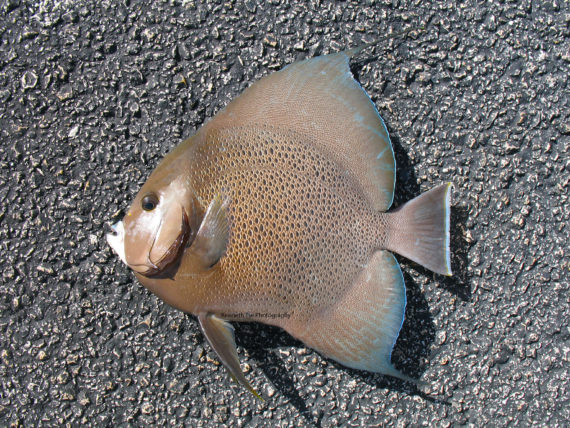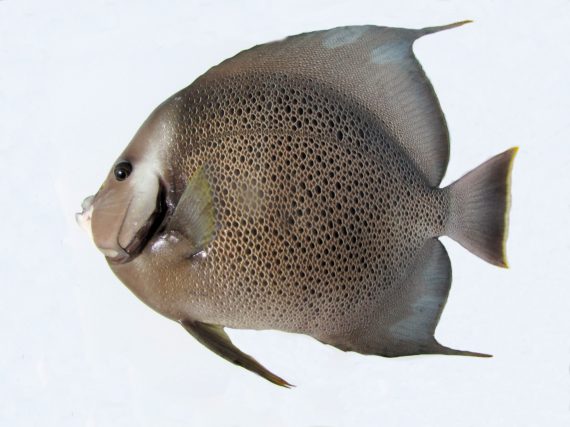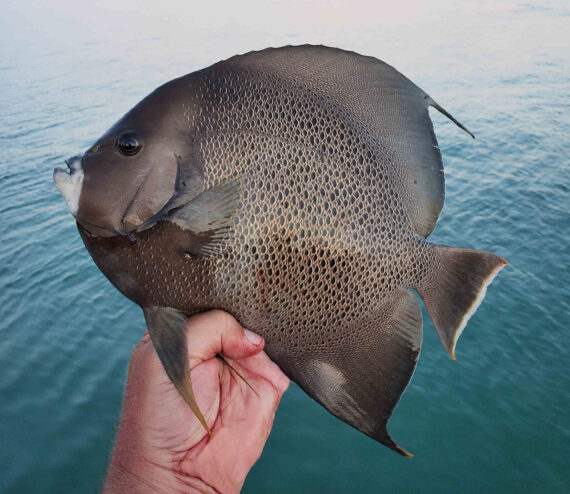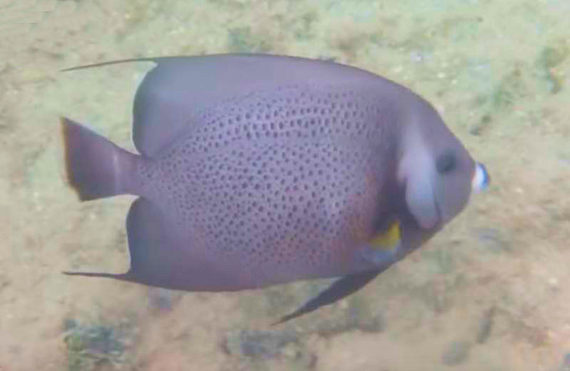Gray Angelfish, Pomacanthus arcuatus
 Gray Angelfish, Pomacanthus arcuatus. Fish caught from coastal waters off Sugarloaf Key, Florida, August 2014. Length: 15 cm (5.9 inches). Catch, photograph, and identification courtesy of Josh Leisen (joshadventures.com), Gaylord, Michigan.
Gray Angelfish, Pomacanthus arcuatus. Fish caught from coastal waters off Sugarloaf Key, Florida, August 2014. Length: 15 cm (5.9 inches). Catch, photograph, and identification courtesy of Josh Leisen (joshadventures.com), Gaylord, Michigan.
 Gray Angelfish, Pomacanthus arcuatus. Fish caught from coastal waters off Fort Lauderdale, Florida, December 2013. Length: 33 cm (13 inches). Catch, photograph and identification courtesy of Eli (obsessiveangling.wordpress.com).
Gray Angelfish, Pomacanthus arcuatus. Fish caught from coastal waters off Fort Lauderdale, Florida, December 2013. Length: 33 cm (13 inches). Catch, photograph and identification courtesy of Eli (obsessiveangling.wordpress.com).
 Gray Angelfish, Somacanthus arcuatus. Fish caught off the Channel 5 Bridge (MM 71.4), Florida Keys, Florida, December 2015. Length: 38 cm (15 inches). Catch, photograph, and identification courtesy of Kenneth Tse, Toronto, Canada.
Gray Angelfish, Somacanthus arcuatus. Fish caught off the Channel 5 Bridge (MM 71.4), Florida Keys, Florida, December 2015. Length: 38 cm (15 inches). Catch, photograph, and identification courtesy of Kenneth Tse, Toronto, Canada.
 Gray Angelfish, Pomacanthus arcuatus. Fish caught from coastal waters off Sugarloaf Key, Florida, August 2014. Length: 41 cm (16 inches). Catch, photograph and identification courtesy of Dean Kimberly, Atlanta, Georgia.
Gray Angelfish, Pomacanthus arcuatus. Fish caught from coastal waters off Sugarloaf Key, Florida, August 2014. Length: 41 cm (16 inches). Catch, photograph and identification courtesy of Dean Kimberly, Atlanta, Georgia.
 Gray Angelfish, Pomacanthus arcuatus. Fish caught from coastal waters off Key Largo, Florida, July 2021. Length: 41 cm (16 inches). Catch, photograph and identification courtesy of Chris Moore, Peoria, Arizona.
Gray Angelfish, Pomacanthus arcuatus. Fish caught from coastal waters off Key Largo, Florida, July 2021. Length: 41 cm (16 inches). Catch, photograph and identification courtesy of Chris Moore, Peoria, Arizona.
 Gray Angelfish, Somacanthus arcuatus. Underwater photograph taken in coastal waters of Yal-Ku, Quintana Roo, April 2017. Photograph courtesy of Juan Rojo, Akumal.
Gray Angelfish, Somacanthus arcuatus. Underwater photograph taken in coastal waters of Yal-Ku, Quintana Roo, April 2017. Photograph courtesy of Juan Rojo, Akumal.
The Gray Angelfish, Pomacanthus arcuatus, is a member of the Angelfish or Pomacanthidae Family, and is known in Mexico as gallineta café. Globally, there are fourteen species in the genus Pomacanthus, of which three are found in Mexican waters, two in the Atlantic and one in the Pacific Ocean.
The Gray Angelfish are a non-migratory species found at depths up to 30 m (100 feet). They have a discus-shaped body that is highly compressed. They are a uniform gray to gray-brown color with scales that have a large dark brown spot in the center and pale gray edges. Their head, chest, caudal fin, pectoral fins, and pelvic fins are dark brown; their caudal fin has a pale gray margin. Their chin and mouth region are white. Juveniles are black with two light yellow bars on their body and three on their head. They have a small mouth which has a protruding lower jaw and comb-like teeth. Their anal fin has 3 spines and 23 to 23 rays; their dorsal fin has 9 spines and 31 to 33 soft rays with extended filaments reaching past their caudal fin which has a straight profile; and, their pectoral fins are long.
The Gray Angelfish is found in shallow waters in reef-associated environments. They reach a maximum of 60 cm (2 feet 0 inches) in length and 1.8 kg (4 lbs 0 oz) in weight but are more common at lengths of 43 cm (17 inches) to 48 cm (19 inches). As of January 1, 2024, the International Game Fish Association world record stood at 1.8 kg (40 lbs 0 oz) with the fish caught in coastal waters off Miami, Florida in July 1999. They are normally solitary but occasionally found in pairs. Juveniles are known to be part-time cleaners of grunts, jacks, morays, snappers, surgeonfish, and wrasses. They primarily consume sponges but are omnivores eating a wide variety of algae and invertebrates. Reproduction is oviparous and monogamous with 25,000 to 75,000 eggs released by each female; the pelagic eggs hatch within fifteen to twenty hours of fertilization and the larvae live in beds of floating plankton before eventually settling out onto the coral reef. The Gray Angelfish is poorly studied with very limited information available about their lifestyle and behavioral patterns including specific details on age, growth, longevity, movement patterns, diet, habitat use, and reproduction.
The Gray Angelfish is most likely confused with the French Angelfish, Pomacanthus paru (yellow rimmed eyes; yellow blotch at pectoral fin base).
The Gray Angelfish has a wide range in the tropical waters of the Western Atlantic being found from the southeast coast of the United States to southern Brazil including the West Indies. In Mexican waters the Gray Angelfish is a resident of all Mexican waters of the Atlantic Ocean including the Gulf of Mexico and the east coast of the Yucatán Peninsula in the Caribbean.
From a conservation perspective the Gray Angelfish is currently considered to be of Least Concern with a stable widely distributed population. They are considered to be an excellent food fish and are marketed fresh and salted, however, they are known to contain ciguatoxin. They are caught primarily by net but can be an excellent game fish on light tackle with small hooks. They are friendly towards divers and a popular subject of underwater photographers. They are also widely sold in the aquarium trade.